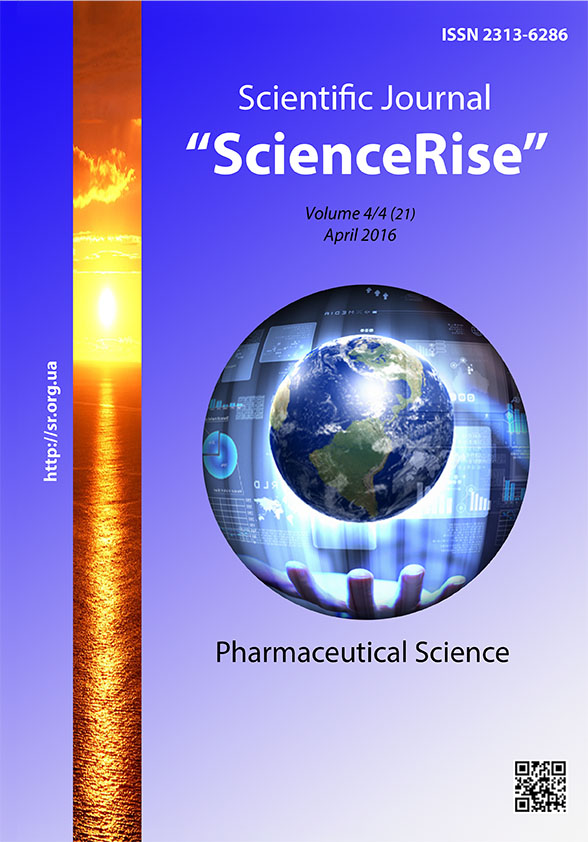Technology of synbiotic bacterial drug production
DOI:
https://doi.org/10.15587/2313-8416.2016.67577Keywords:
bifidobacteria, lactobacillus, lactitol, consortium, symbiosis, synbiotic, simultaneous deep cultivation, acid production activity, bacterial drugAbstract
Aim. To increase the range of synbioltic drugs, technology for the complex bacterial drug production and methods for its quality control were developed.
Methods. For the high-effective remedy development, determination of type of bacteria symbiotic relationship in its composition was carried out. Considering the individuality of each strain in their requirements for nutrients in growth medium, its optimal composition was selected, which allows to carry out simultaneous deep cultivation of bacteria strains, maintaining both morphological features and activity of each strain. Determination of physical and technological cultivation parameters considers the bacteria exponential growth phase and allows maintaining active growth parameters. To improve the bacteria growth parameters, a prebiotic component, having equally high bifidobacteria and lactogenic effects, was included.
Results. Technology of the complex remedy production and its quality control methods were developed.
Conclusion. The obtained results in relation to the developed remedy quality control in experiments in vitro and in vivo confirm the compliance of the obtained drug to quality and safety requirements
References
Glushanova, N. A., Shenderov, B. A. (2005). Vzaimootnosheniya probioticheskikh i indigennykh laktobacill v usloviyakh sovmestnogo kultivirovaniya in vitro [The relationship of probiotic lactobacilli and indigenous bacteria in the condition of cocultivation in vitro]. Zhurnal mikrob., epidemiol., i immunobiol., 2, 56–61.
Patent RF 2257408. Lechebno-profilakticheskiy biopreparat na osnove sukhoy biomassy bifido- i laktobakteriy, biologicheski aktivnaya dobavka k pishche na osnove sukhoy biomassy bifido- i laktobakteriy, sukhaya biomassa bifido- i laktobakteriy i sposob ee polucheniya [Therapeutic and prophylactic biological drug on the basis of the dry biomass of bifidobacteria and lactobacilli, biology active food supplement based on dry biomass of bifidobacteria and lactobacilli, dry biomass of bifidobacteria and lactobacilli and method there of this production] (2003). 2003136785/13; zajavl. 22.12.2003 g.; opubl. 27.07.2005 g.
Zubareva, I. M., Fedorova, I. S., Zubova, A. V. (2004). Razrabotka glubinnykh pitatel'nykh sred v proizvodstve biosporina [Development of the deep culture media in the production of biosporin]. Voprosy khimii i khimicheskoy tekhnologii, 1, 85–88.
Krasnopol'skiy, Yu. M. (2009). Probiotiki v sostave biologicheskikh dieticheskikh dobavok [Probiotics in the consist of biological dietary supplements]. BAD-ekspert, 1, 18–22.
Semchenko, A. V., Kaz'janin, A. V., Orlova, E. V., Neschisljaev, V. A. (2007). Sovershenstvovanie sposoba polucheniya probioticheskikh preparatov [Improving the process for the preparation of probiotic drugs]. Fundamental'nye issledovaniya, 12, 350–351.
Khyzhnyak, O. S., Krasnopol's'kyy, Yu. M. (2013). Biotekhnolohichni aspekty otrymannya kompleksnoho preparatu, yakyy mistyt' rizni shtamy probiotychnykh kul'tur [Biotechnological aspects of obtaining the complex drug, which consist of different strains of probiotic culture]. Visnyk NTU «KhPI». Kharkiv, 4, 113–120.
Khyzhnyak, O. S. (2014). Vyznachennya prebiotychnykh vlastyvostey zaminnyka tsukru laktytolu v umovakh in vitro [Determination of prebiotic properties of sugar substitude lactitol in vitro]. Visnyk NTU "HPI". Serija: Novi rishennja v suchasnyh tehnologijah. Kharkiv: NTU "HPI", 26 (1069), 140–148.
Krasnopol's'kyy, Yu. M., Borshchevskaya, M. I. (2009). Farmatsevticheskaya biotekhnologiya. Tekhnologiya proizvodstva immunobiologicheskikh preparatov [Pharmaceutical biotechnology]. Khar'kov: NTU «KhPI», 352.
Ashmaryn, V. P., Vorobjov, A. A. (1962). Statystychni metody v mikrobiolohichnykh doslidzhennyakh [Statistical methods in microbiological studies]. Lviv: Medhyz, 85.
Pimenov, E. V., Oboryn, V. A., Yvonyn, A. G. (2011). Otsenka adgezivnykh svoystv spor vaktsinnykh shtammov Bacillus Anthracis na eritrotsitakh mlekopitayushchikh s pomoshch'yu fotokolorimetrii [Evaluation of adhesive properties of spore vaccine strains of Bacillus Anthracis on erythrocytes of mammals using photocolorimetry]. Problemy osobo opasnykh infektsiy, 110, 41–43.
Makhrova, T. V., Zaslavskaja, M. Y., Majanskyj, A. N. (2004). Vliyanie metabolitov stafilokokkov na adgezivnye reaktsii v sisteme «Candida albicans – bukkal'nye epiteliotsity» [Influence of staphylococcal metabolites on reaction adhesive system “Candida albicans – buccal epithelial cells]. ZhMEI, 5, 4–7.
Khyzhnyak, O. S. (2015). Vyvchennya adhezyvnykh vlastyvostey bifidobakteriy ta laktobatsyl pry sumisnomu kul'tyvuvanni [Study of adhesive properties of bifidobacteria and lactobacilli in the joint cultivation]. Farmakom, 1, 71–74.
Anisimov, T. I., Bukovskaja, S. N. et. al (1989). Rukovodjashhij dokument po standartizacii. rD 42-28-8-89 / Doklinicheskie ispytanija novyh medicinskih immunobiologicheskih preparatov [Guidance document on standardization. 42-28-8-89 pA / Pre-clinical testing of new medical immunobiological preparations]. Moscow, 31.
Khyzhnyak, O. S. (2015). Rozrobka skladu kapsul'noyi masy profilaktychnoho zasobu na osnovi probiotychnykh bakteriy [Development of the capsule mass of drug based on probiotic bacteria]. Farmakom, 3-4, 43–48.
Downloads
Published
Issue
Section
License
Copyright (c) 2016 Оксана Сергіївна Хижняк

This work is licensed under a Creative Commons Attribution 4.0 International License.
Our journal abides by the Creative Commons CC BY copyright rights and permissions for open access journals.
Authors, who are published in this journal, agree to the following conditions:
1. The authors reserve the right to authorship of the work and pass the first publication right of this work to the journal under the terms of a Creative Commons CC BY, which allows others to freely distribute the published research with the obligatory reference to the authors of the original work and the first publication of the work in this journal.
2. The authors have the right to conclude separate supplement agreements that relate to non-exclusive work distribution in the form in which it has been published by the journal (for example, to upload the work to the online storage of the journal or publish it as part of a monograph), provided that the reference to the first publication of the work in this journal is included.

